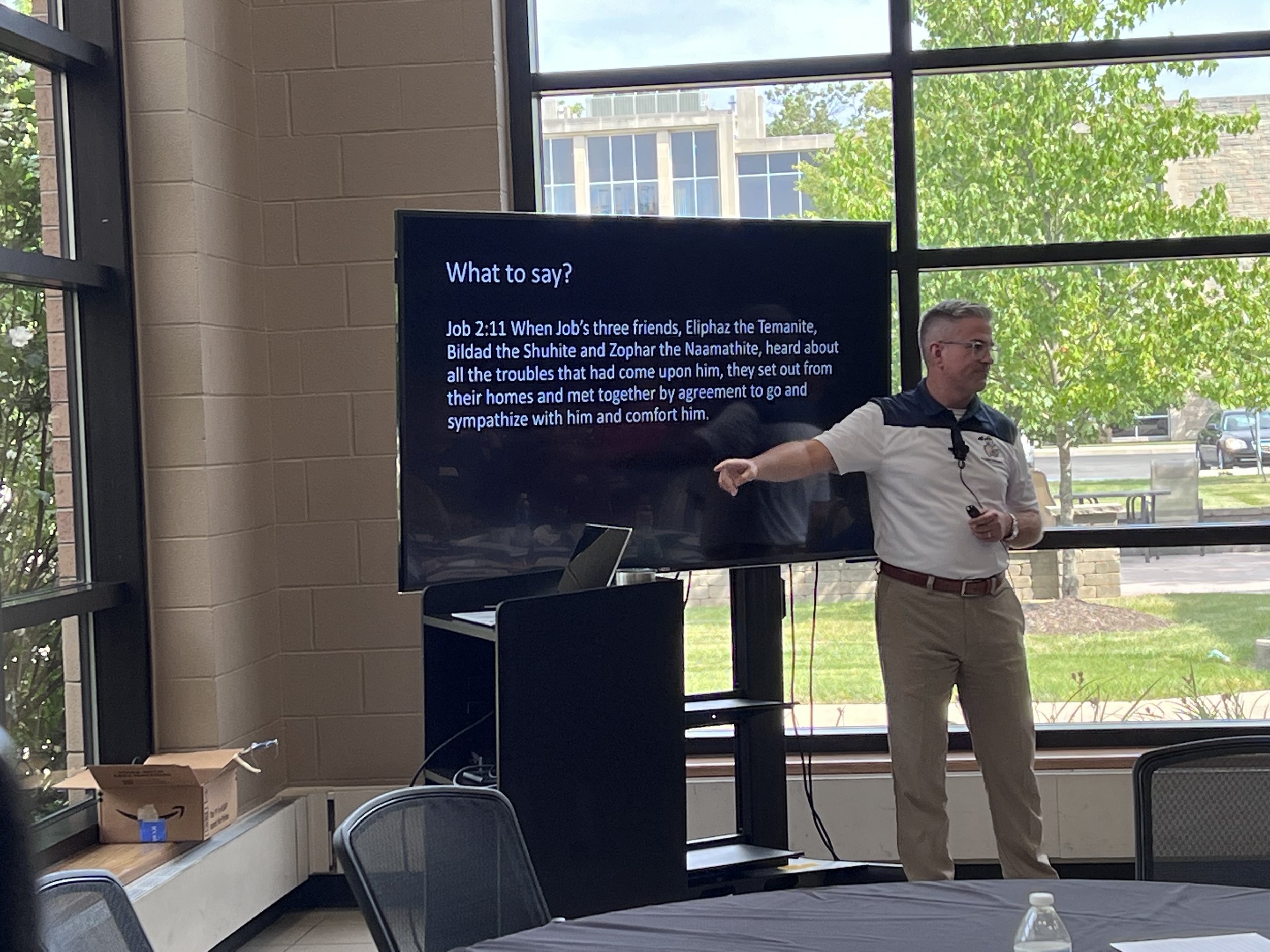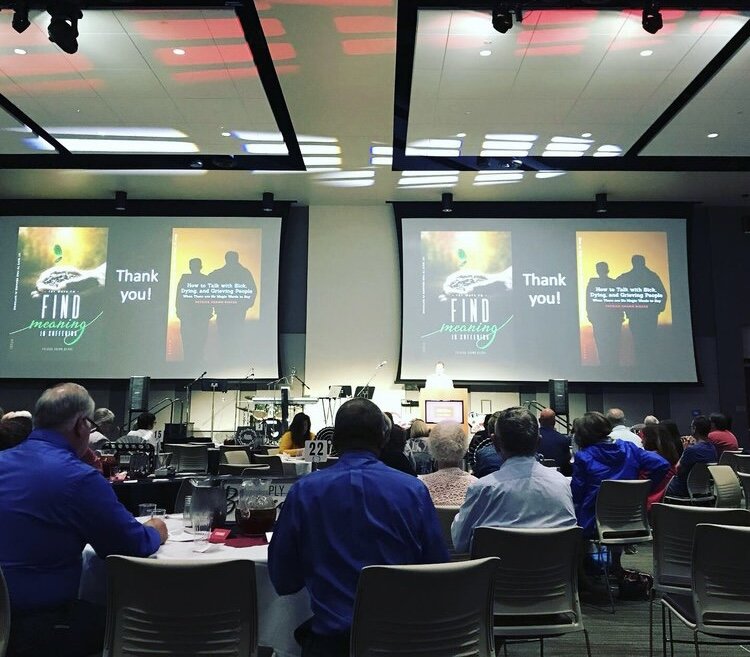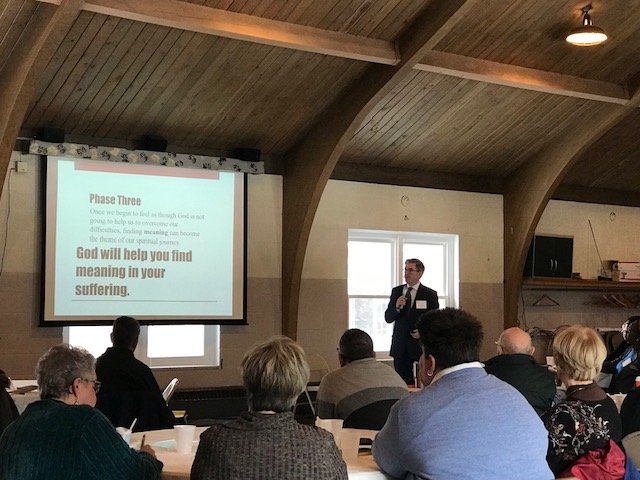Burnout Resources
-
Let’s Talk About Healthcare Burnout: A Prevention and Recovery Guidebook by Rev. Patrick Riecke and Dr. Erin Alexander
This resource will guide your path to burnout prevention and recovery. This eBook provides actionable strategies, inspiring insights, and a clear path forward. Purchase your copy to begin transforming your experience.
-
Discover your level of burnout with our free online screening tool. This simple, science-backed assessment helps you understand emotional exhaustion, depersonalization, and personal accomplishment to identify your risk of burnout. Start your journey toward recovery today.
-
This affordable, life-changing mini-course helps you refocus your energy on what truly matters. Learn how to prioritize self-care and design a purpose-driven life while preventing burnout. Available exclusively for $24.99. Sign up here.
-
Whether you're an individual recovering from burnout or a leader looking to help your team, I offer tailored workshops, keynotes, and coaching. Let’s work together to create lasting change and improve wellbeing in your life or organization. Contact Patrick today.
-
Explore articles packed with practical advice, personal insights, and expert strategies on preventing and recovering from burnout. Updated regularly, this blog dives into topics ranging from personal recovery to organizational solutions.
-
This downloadable guide highlights the most effective strategies organizations can implement to reduce burnout among employees. From fostering a supportive workplace culture to addressing systemic issues, this resource is ideal for HR and leadership teams. Click here for the PDF.
-
This practical guide walks individuals through their personal recovery from burnout. With actionable steps, reflective exercises, and inspirational insights, this PDF is your roadmap to a healthier, more balanced life. Click here for PDF.
-
Get personalized support through 1-on-1 executive coaching sessions designed to help you understand and combat burnout. Together, we’ll develop a plan to renew your energy, improve work-life balance, and thrive. Click here for coaching.
-
This comprehensive course offers a step-by-step approach to burnout recovery and prevention. Learn how to identify burnout symptoms, implement recovery strategies, and live with greater vitality and purpose. Available for $249.99.




























The Role of Leadership in Preventing Burnout
Effective leadership is crucial in preventing burnout and supporting employee well-being. Learn how leaders can foster a supportive work environment and mitigate burnout risks.
Leadership plays a critical role in preventing burnout and supporting employee well-being. Effective leaders can create a work environment that fosters engagement, reduces stress, and promotes overall health. How can leaders contribute to preventing burnout and what strategies should they employ?
Leadership Strategies to Prevent Burnout:
Listening and Support:
Leaders should actively listen to their employees' concerns and provide support.
Regular one-on-one meetings and open-door policies can help employees feel heard and valued.
Promoting Work-Life Balance:
Encourage employees to take breaks, use their vacation time, and set boundaries between work and personal life.
Implement flexible work policies to help employees manage their workload effectively.
Recognizing and Rewarding Efforts:
Acknowledge and celebrate employees' hard work and achievements.
Implement recognition programs that highlight individual and team accomplishments.
Providing Resources and Training:
Offer access to mental health resources, counseling services, and stress management programs.
Provide training for leaders to recognize signs of burnout and support their teams effectively.
Creating a Positive Work Environment:
Foster a culture of respect, collaboration, and open communication.
Address any toxic behaviors or practices that contribute to stress and burnout.
Conclusion:
Effective leadership is essential in preventing burnout and promoting a healthy workplace. By listening to employees, promoting work-life balance, recognizing efforts, providing resources, and fostering a positive work environment, leaders can mitigate the risks of burnout and support their team's well-being.
Implementing Effective Well-Being Programs
Comprehensive well-being programs are crucial for preventing burnout and supporting employee health. Discover the key characteristics of effective well-being programs and how to implement them successfully.
In today's fast-paced work environment, employee well-being is critical for organizational success. Burnout, stress, and mental health issues are rampant, especially in high-pressure fields like healthcare and education. Implementing effective well-being programs can help mitigate these issues and promote a healthier, more productive workforce.
Characteristics of Effective Well-Being Programs:
Holistic Health Support:
Address physical, mental, emotional, and social health.
Include programs like fitness challenges, mental health screenings, and mindfulness sessions.
Organizational Support:
Leadership involvement and support are crucial.
Policies that promote work-life balance, such as flexible working hours and adequate vacation time.
Personalization:
Offer a variety of options to cater to individual needs and preferences.
Use surveys and feedback mechanisms to tailor programs to employee needs.
Accessibility:
Ensure resources are easily accessible to all employees.
Provide clear information about available resources and how to access them.
Culture of Continuous Improvement:
Regularly assess the effectiveness of well-being initiatives.
Be open to feedback and willing to adapt programs based on employee input.
Implementing Well-Being Programs:
Leadership Commitment: Leaders should actively participate in well-being initiatives and model healthy behaviors.
Employee Involvement: Engage employees in the design and implementation of well-being programs to ensure they meet their needs.
Clear Communication: Communicate the benefits and availability of well-being resources effectively.
Ongoing Evaluation: Continuously monitor and evaluate the effectiveness of well-being programs and make necessary adjustments.
Conclusion:
Effective well-being programs are essential for preventing burnout and promoting a healthy, productive workforce. By addressing all aspects of health, gaining organizational support, and continuously improving, organizations can create a supportive environment that fosters employee well-being and enhances overall performance.
The Dark Side of Burnout: Suicide Risk
Burnout significantly increases the risk of suicide among healthcare professionals. Understand the dark side of burnout and the urgent need for comprehensive mental health support.
Burnout is not just about exhaustion and disengagement; it can have fatal consequences. One of the darkest aspects of burnout is the increased risk of suicide among healthcare professionals. What leads to this tragic outcome, and how can we provide better support?
Increased Risk of Suicide:
Healthcare professionals, particularly physicians, have some of the highest suicide rates in the U.S. The constant stress, emotional exhaustion, and lack of support contribute to feelings of hopelessness and despair.
Contributing Factors:
Emotional Exhaustion: Chronic fatigue and stress can lead to feelings of hopelessness.
Depersonalization: Emotional numbness and detachment can increase the risk of suicide.
Low Sense of Accomplishment: Feeling ineffective and unfulfilled can contribute to depression and suicidal thoughts.
Providing Support:
Mental Health Resources: Ensure access to mental health support, including counseling and therapy.
Supportive Work Environment: Create a culture where employees feel supported and valued.
Open Conversations: Encourage open discussions about mental health and the challenges of the profession.
Conclusion:
The increased risk of suicide among healthcare professionals underscores the urgent need for comprehensive mental health support. By addressing the root causes of burnout, we can save lives and promote a healthier work environment.
The Deep Wounds of Moral Distress
Let’s delve into the concept of moral distress. Remember, moral distress occurs when we take an action or witness an action that violates our inner values. It’s important to acknowledge that our inner values differ from person to person. What bothers one person deeply might not affect another as much. These values are shaped by various factors such as upbringing, culture, religious background, personality, and past experiences. Moral distress arises when something goes against these deeply held values.
Sometimes moral distress is triggered by a single event, while other times it's a result of systemic issues, policies, or cultural norms—like water dripping on a rock until its strength is eroded. In this chapter, I (Patrick) will share two personal experiences of moral distress.
Zero-Visitor Policy
At the onset of the pandemic, many healthcare facilities, including nursing homes and hospitals, implemented a zero-visitor policy. At the time, I was a department director and the chairperson of the Ethics Committee for a large health system. I was responsible for advising on whether we should adopt this policy, which would close our doors to visitors, family included. Given the circumstances, I recommended that we follow suit, which unfortunately meant patients would die without their loved ones by their side, only accompanied by healthcare workers.
Despite my recommendation, our health system did not immediately implement the zero-visitor policy. Although the delay felt lengthy at the time, in hindsight, it probably wasn’t very long. Nonetheless, as chair of the Ethics Committee, I felt our recommendation should be promptly followed, as it was thoroughly considered and well-intentioned.
Three aspects of this situation caused me significant moral distress. First, the Ethics Committee's recommendation was briefly ignored, conflicting with my belief that such recommendations should be heeded. Second, I felt terrible about making the recommendation. As the leader of the chaplaincy department, it was a complete reversal of our usual values, which emphasized the presence of loved ones during critical moments. Third, about a year later, our state passed a law prohibiting zero-visitor policies in the future, making me feel morally distressed for having supported a now illegal policy.
The Full-Code Patient
Now, let’s shift to a more clinical example of moral distress experienced by nurses. Years ago, we had an elderly, frail patient with necrosis of the brain and metastasized cancer. She had multi-organ failure and was vent-dependent. She was in bad shape, to say the least. My heart went out to her. However, despite her dire condition, her family insisted on keeping her a full code, demanding that everything possible be done to preserve her life.
For the healthcare team, this was a source of moral distress. They knew that resuscitating her would not change the inevitable outcome due to her severe conditions. Even a non-clinical reader can easily understand that if this patient regained pulses following CPR, that would not remedy her cancer, dead brain tissue, and organs that had stopped working. Day after day, nurses, patient care techs, respiratory therapists, physicians, and others, dreaded the possibility of this frail patient’s heart stopping.
Late one night, the situation came to a head when she flatlined, and all the alarms sounded. Following protocol, the team performed CPR, including chest compressions and other resuscitative measures on this frail patient. This was deeply distressing for the staff, who felt they were violating their own values by providing aggressive care that seemed futile and inhumane. Not to mention that the only family member in the room was the patient’s granddaughter. Since she was not the designated decision maker for the patient, she could only watch her grandmother’s last moments on earth, characterized by the trauma of CPR.
It was awful.
While these examples may seem extreme, healthcare workers know that morally distressing situations are commonplace.
An office policy about the number of patients to be seen requires a physician to rush her visits and express less compassion that is natural for her. HIPAA laws keep front desk coworkers from being straightforward about the work happening around them, sometimes leading to interpersonal conflict. Financial pressures prevent a nurse from providing the medications or supplies he believes would be most appropriate for a certain patient. These sources of distress are woven into the daily lives of healthcare workers.
I used to feel as though there was an evil person behind every morally distressing situation. If we could just find him and remove him, the stress and obstacles would all dissolve. Of course, that was a child’s fantasy.
While there are plenty of misguided or inept leaders making things more difficult, the system itself provides moral distress and burnout opportunities even if every executive is kind and supportive.
Despite being normal and commonplace, moral distress inflicts a cost on us—particularly when it is sudden or profound. This can lead to moral injury, a deeper wound to our inner selves. Moral distress and injury can pave the way to burnout, making it challenging to reverse the damage done.
Soon, we will consider how burnout feels. But first, Erin explains the phenomena of vicarious trauma, moral injury, and compassion fatigue.
Qualitative Consequences of Burnout
Beyond the numbers, burnout has significant qualitative consequences on personal well-being and workplace culture. Understand these human aspects and the need for supportive environments.
While the quantitative impact of burnout is significant, the qualitative consequences are equally important. Burnout affects personal well-being, workplace culture, and overall job satisfaction. What are these human aspects, and how can we address them?
Decreased Employee Satisfaction:
Burnout leads to decreased job satisfaction, leaving employees feeling unfulfilled and disengaged. This can result in higher turnover rates and a negative workplace culture.
Reduced Empathy:
Burned-out professionals often experience reduced empathy, impacting their interactions with colleagues and patients. This emotional numbness can lead to errors and a decline in the quality of care.
Personal Well-being:
Burnout takes a toll on personal well-being, leading to stress, anxiety, and strained relationships. It can affect every aspect of life, from physical health to mental health.
Conclusion:
The qualitative consequences of burnout highlight the need for supportive work environments that prioritize employee well-being. By addressing these human aspects, we can improve job satisfaction, enhance empathy, and promote overall well-being.
Burnout for Beginners
Taken from “Let’s Talk About Healthcare Burnout: A Prevention and Recovery Guidebook,” by Rev. Patrick Riecke and Dr. Erin Alexander DNP.
+++
Let's begin by outlining where we’re headed. We'll define key terms like "moral distress" and "burnout." The term "burnout" is frequently used, but it has specific, technical definitions and distinct characteristics, especially in the workplace. We’ll delve into these definitions and characteristics, particularly how they manifest in our professional lives, and bleed over into our personal lives.
As we start to uncover the complex crisis of burnout, it's crucial to understand the emotional toll it takes on healthcare workers. Dr. Erin Alexander delves into this in chapter four, where she discusses vicarious trauma and compassion fatigue in detail.
We'll examine various studies and statistics. Unsurprisingly, burnout, moral distress, and work-related mental health issues have been extensively studied, particularly in the healthcare and education sectors. We’ll review some of these findings to provide a solid grounding.
Next, we’ll discuss examples of moral distress. While having a technical definition is helpful, it’s crucial to understand what moral distress looks and feels like in the workplace. I’ll also share my personal burnout story, detailing my experiences in healthcare during the pandemic and beyond.
We’ll explore the stakes involved. What happens if we don’t address burnout? What are the costs of failing to create supportive systems in our workplaces? We’ll also look at the organizational path: what can leaders do to prevent burnout and foster a supportive culture? This leads naturally into Dr. Alexander's exploration of psychological safety in the workplace in chapter nine.
Finally, we’ll discuss the personal path. If you’re currently experiencing burnout, know that you’re not alone. This conversation is largely for you. We’ll cover practical steps and innovative methods to recover from burnout and offer some encouragement along the way. We want to warn you that this topic is very personal to both of us, and our experiences will be woven throughout our discussion.
In most chapters, the voice will be Patrick's, but Erin's influence is ever-present.
The remainder of this chapter introduces historical voices in burnout study, technical definitions of moral distress and burnout, and studies and statistics around the crisis.
Pioneers in Burnout
Christina Maslach is a pioneering figure in the field of burnout research. Her work, particularly the Maslach Burnout Inventory (MBI), has provided a foundational framework for understanding burnout's core components: emotional exhaustion, depersonalization, and a reduced sense of personal accomplishment.
Maslach's research emphasizes how chronic workplace stress leads to burnout. Her insights have shaped interventions designed to mitigate burnout and promote well-being, making her work essential for anyone seeking to understand and address this pervasive issue.
Johnathon Shay and Andrew Jameton have also made significant contributions to our understanding of burnout, particularly through the lenses of moral distress and moral injury.
Shay's work, especially with veterans, introduced the concept of moral injury, which occurs when individuals witness or partake in actions that violate their ethical beliefs, leading to profound psychological distress. Jameton expanded on this idea within the healthcare context, coining the term "moral distress" to describe the experience of knowing the right action to take but being constrained from taking it. Together, their work highlights the deep emotional and ethical impacts that can contribute to burnout, especially in high-stakes environments.
A Framework
To provide a framework, researcher Amanda Rosen and her team describe a continuum from moral awareness to moral distress to moral injury, often leading to burnout.
Moral awareness is having a sense of how things should be at work—an awareness of right and wrong. This can vary, but it often involves a moral sense of the quality of care, patient treatment, and standards that should be met.
Not everyone starts with moral awareness. Some coworkers are simply trying to avoid trouble or pay the bills and may not engage deeply with concepts like moral distress or burnout.
However, for those of us in helping professions, moral awareness is common and important. Most of us have some sense of “right and wrong” when it comes to our work. That’s good, but it sets us up for dissonance when things don’t go as they should, leading to moral distress—a violation of our internal ethics.
When moral distress is profound or sudden, it can escalate to moral injury, and potentially burnout. So, moral distress occurs when actions or situations violate your personal values. If this distress is severe or prolonged, it can result in moral injury, causing deeper internal harm.
Next, let's explore the characteristics of burnout.
The Three Characteristics
Emotional exhaustion, burnout's first characteristic, is not just tiredness after a long day. It is a deep-seated fatigue that persists even after rest. For self-reflection, recall the last time you returned to work after some time away (for vacation, a holiday, or medical leave). What feelings did you have? If the only feelings that come to mind are anxiety, dread, and fatigue, then you might be emotionally exhausted.
The second characteristic of burnout, depersonalization, involves a loss of connection to others, often manifesting as cynicism. Cynicism is something deeper than sarcasm. In fact, sarcasm can illuminate truth. But cynicism is a deeper level of hopelessness, a sense that nothing will ever improve. When we are in this state, even good news is received with a subtle sense of dread and defeat.
Lastly, a lowered sense of accomplishment occurs when you no longer feel your work makes a meaningful difference. Perhaps you took the job because you believed that you could make an impact. Now, things have changed, and you’re just trying to survive.
People who are burned out feel like their actions don’t matter much.
Statistics and Studies
Burnout is a common experience, particularly in healthcare. And while the COVID-19 pandemic did not introduce healthcare burnout, and its end did not resolve it, the impact from 2020-2022 is clear. Between 18% and 25% of coworkers left their jobs in the first year and a half of the pandemic.
Many nurses and physicians have left their fields entirely. A recent survey found that 2.7 million US nurses are currently experiencing burnout, representing 15% of the entire healthcare workforce.
Burnout symptoms are prevalent among nurses: at least 25% report symptoms like stress, anxiety, and depression. One study found that 95% of nurses felt burned out at some point in the past three years. Additionally, 27% of nurses who quit cited burnout as the primary reason. The annual turnover rate for nurses is over 25%, with nursing homes seeing even higher turnover rates, sometimes exceeding 50%.
An American Association of Critical-Care Nurses survey found that 92% of nurses believe their experiences during the pandemic will shorten their careers.
An article from The Atlantic highlighted that between 35% and 54% of nurses and physicians felt overwhelmed before the pandemic, a situation exacerbated by COVID-19.
Healthcare leaders face unique challenges. Often overlooked in burnout research, leaders experience hyper-responsibility and guilt when taking time for their own well-being. This hyper-responsibility and perceived lack of empowerment can lead to burnout.
For managers, several daily factors can also lead to burnout:
Increased workloads
Staffing shortages
Emotional strain
Insufficient resources
A lack of recognition
For coworkers under their leadership, who are hands-on with patients, there are similar contributors to burnout:
Physical demands
Emotional stressors
A perceived lack of support
High workloads
These challenges are compounded by the emotional toll of patient care and turnover in their work environment.
Conclusion
In conclusion, staffing shortages and employee burnout continue to plague healthcare. It’s unlikely that this comes as a surprise to you. If you are a healthcare worker, you know that morale is sagging, hours are long, and systems are convoluted. But what do we do about it? Can organizations change the experiences of coworkers? Even more importantly, what can stressed out coworkers do to care for themselves before it’s too late?
As we move forward, we’ll explore the concept of moral distress, a key component of burnout, and explore its profound impact on healthcare professionals.
Quantitative Impact of Burnout
Burnout has a significant quantitative impact on healthcare, leading to severe shortages and economic costs. Understand the numbers behind burnout and the urgent need for action.
Burnout is often discussed in qualitative terms, but its quantitative impact is equally alarming. The numbers reveal a stark reality of shortages and economic costs. What do these statistics tell us, and why is it crucial to address burnout now?
Shortages in Healthcare:
The U.S. is predicted to face a shortage of up to 94,000 physicians by 2025 due to burnout. Similarly, many nurses are considering leaving the profession, with 62% of acute care nurses believing the pandemic will shorten their careers. These shortages will significantly impact patient care and access to healthcare.
Economic Costs:
Burnout leads to increased turnover, reduced productivity, and higher healthcare costs. The loss of experienced professionals and the need for recruiting and training new staff can be costly. Organizations also face higher rates of absenteeism and decreased employee engagement.
Conclusion:
The quantitative impact of burnout is clear and alarming. By understanding the numbers, we can see the urgent need for action to address burnout, support healthcare professionals, and ensure the sustainability of our healthcare systems.
Surgeon General's Warning on Burnout
The Surgeon General's warning highlights a critical healthcare crisis: burnout. Learn about the predicted shortages of healthcare professionals and the urgent need for systemic change.
Burnout in healthcare is not just a personal issue but a looming crisis. The U.S. Surgeon General has issued warnings about the severe implications of burnout on the healthcare system. What does this warning entail, and why is it crucial to address burnout immediately?
Predicted Shortages:
According to the Surgeon General, the U.S. is facing a significant shortage of healthcare professionals due to burnout. By 2025, the country could be short of 41,000 to 94,000 physicians. This shortage will exacerbate the existing challenges in healthcare access and quality.
Impact on Nurses:
A study found that 62% of acute care nurses believe the pandemic will shorten their careers. If even half of these nurses leave the profession, it will lead to a severe reduction in the nursing workforce, further straining healthcare systems.
Systemic Changes Needed:
Addressing burnout requires systemic changes. Healthcare organizations must implement policies that support the well-being of their staff. This includes providing adequate resources, creating supportive work environments, and prioritizing mental health.
Conclusion:
The Surgeon General's warning underscores the urgent need to address burnout in healthcare. By making systemic changes, we can prevent a healthcare crisis, ensure the well-being of professionals, and improve patient care.
The High Stakes of Burnout
The consequences of burnout extend beyond individual well-being, affecting organizational performance and patient care. Understand the high stakes of burnout and why it's crucial to take action now.
Burnout isn't just an individual issue; it's a crisis with far-reaching consequences for both individuals and organizations. The stakes are incredibly high, especially in sectors like healthcare. If we don't address burnout effectively, we risk significant negative impacts. What are these high stakes, and why is immediate action crucial?
Impact on Healthcare Systems:
Burnout in healthcare leads to a decline in the quality of patient care. Burned-out healthcare professionals are more likely to make errors, have lower patient satisfaction scores, and exhibit reduced empathy. This not only affects patient outcomes but also the overall trust in healthcare systems.
Physician and Nurse Shortages:
The U.S. Surgeon General has highlighted the impending shortage of physicians and nurses due to burnout. By 2025, the U.S. is expected to face a shortage of 41,000 to 94,000 physicians. Similarly, many nurses are leaving the profession due to the stress and demands, exacerbated by the COVID-19 pandemic. This shortage will further strain healthcare systems and reduce access to care.
Economic Costs:
Burnout has significant economic implications. It leads to increased turnover, reduced productivity, and higher healthcare costs for organizations. The loss of experienced professionals and the cost of recruiting and training new staff can be substantial.
Qualitative Consequences:
Beyond the numbers, the qualitative consequences of burnout are profound. It leads to decreased employee satisfaction, reduced engagement, and a negative workplace culture. Burnout also impacts personal lives, contributing to stress, anxiety, and strained relationships.
Conclusion:
The high stakes of burnout demand immediate action from both individuals and organizations. By addressing burnout, we can improve the well-being of professionals, enhance patient care, and create a more sustainable and productive work environment.
Creating a Supportive Workplace to Prevent Burnout
A supportive workplace is essential for preventing burnout. Learn key strategies to foster a healthy, engaging work environment and support employee well-being.
Preventing burnout starts with creating a supportive workplace. By fostering a healthy and engaging environment, organizations can help employees thrive and maintain their well-being.
Key strategies for creating a supportive workplace include promoting open communication, offering flexible work arrangements, and providing resources for mental health support. Encouraging regular feedback and involving employees in decision-making processes can also help create a sense of ownership and engagement, reducing the risk of burnout.
Employers can support mental health by providing access to counseling services, promoting wellness programs, and encouraging a healthy work-life balance. This might include offering flexible work hours, remote work options, and regular mental health days.
Creating opportunities for professional growth and development is also crucial. Providing training, mentorship programs, and career advancement opportunities can help employees feel valued and motivated. Recognizing and celebrating achievements, both big and small, can also boost morale and prevent burnout.
In addition, fostering a culture of collaboration and support can help employees build strong relationships and feel connected to their work. This might involve team-building activities, regular check-ins, and creating spaces for open and honest communication.
By implementing these strategies, organizations can create a supportive and engaging work environment that helps prevent burnout and promotes overall well-being. This not only benefits employees but also enhances overall organizational performance and resilience.
Personal Stories of Moral Distress and Recovery
Personal stories of moral distress offer valuable insights into overcoming ethical challenges. Learn from real-life experiences and discover recovery strategies.
Personal stories of moral distress offer valuable insights into the emotional and ethical challenges professionals face. These real-life experiences highlight the importance of support and recovery strategies.
One example involves a healthcare professional who faced moral distress due to policy changes that limited patient care options. By seeking support from colleagues and engaging in ethical discussions, they were able to navigate these challenges and find a path to recovery.
A teacher experienced moral distress when required to enforce disciplinary measures they believed were unjust. By joining a support group and advocating for policy changes, they found a way to align their actions with their values and reduce their distress.
Sharing these stories can inspire others to seek help and highlight the importance of supportive workplace environments in addressing moral distress. Employers can create platforms for employees to share their experiences and learn from one another.
In addition, providing resources such as counseling services, ethics training, and opportunities for professional development can help individuals recover from moral distress and build resilience. By fostering a culture of support and understanding, organizations can help employees navigate ethical challenges and maintain their well-being.
Strategies for Mitigating Moral Distress in the Workplace
Mitigating moral distress requires effective strategies and a supportive work environment. Discover how to foster ethical discussions and provide necessary support.
Mitigating moral distress in the workplace requires a proactive approach. By implementing effective strategies, organizations can create supportive and ethical environments that help employees navigate challenging situations.
Key strategies for mitigating moral distress include providing regular training on ethical decision-making, establishing clear channels for ethical consultations, and fostering a culture of open communication. This might involve creating ethics committees or support groups where employees can discuss their concerns and seek guidance.
Encouraging employees to voice their concerns without fear of retribution is crucial. Organizations should establish clear protocols for addressing ethical issues and ensure that employees feel safe and supported when raising concerns. Providing access to counseling services and promoting mental health awareness can also help mitigate the impact of moral distress.
Regularly reviewing and updating organizational policies to align with ethical standards is another important strategy. This ensures that policies are flexible enough to accommodate the needs of both employees and clients. Employers should also encourage a culture of ethical awareness by promoting transparency and accountability.
By addressing moral distress proactively, organizations can create a healthier and more supportive work environment. This not only benefits employees but also enhances overall organizational performance and resilience.
The Impact of Moral Distress on Healthcare Professionals
Moral distress significantly impacts healthcare professionals. Understand its effects and explore strategies to support these essential workers.
Healthcare professionals often face ethical dilemmas that can lead to moral distress. This distress can have a profound impact on their well-being and job performance.
Moral distress in healthcare can result from policies that limit treatment options or situations where professionals feel unable to provide the best care possible. For example, during the COVID-19 pandemic, many healthcare workers faced moral distress when resources were scarce, and they had to make difficult decisions about patient care.
This distress can lead to burnout, decreased job satisfaction, and high turnover rates. Healthcare professionals experiencing moral distress may also suffer from anxiety, depression, and other mental health issues. The emotional toll of constantly facing ethical dilemmas can be overwhelming.
Supporting healthcare professionals involves providing resources for ethical consultations, fostering open communication, and ensuring that policies are flexible enough to accommodate the needs of both patients and staff. This might include creating ethics committees, offering regular training on ethical decision-making, and providing access to counseling services.
Organizations can also promote a culture of support and understanding by encouraging healthcare professionals to discuss their experiences and seek guidance when facing ethical dilemmas. By addressing moral distress proactively, healthcare institutions can help maintain the well-being of their staff and ensure the highest quality of patient care.
Identifying Moral Distress in the Workplace
Moral distress can be subtle but significant. Learn to identify key signs and explore effective solutions to support affected individuals in the workplace.
Moral distress can be subtle but significant, impacting individuals' emotional and professional well-being. Recognizing the key signs is essential for providing the necessary support.
Signs of moral distress include feelings of frustration, powerlessness, and guilt when one's actions conflict with their ethical beliefs. These feelings can lead to burnout if not addressed. For instance, a teacher might feel powerless when unable to provide adequate support to students due to restrictive school policies.
Other signs of moral distress include anxiety, insomnia, and a sense of being trapped in a situation that goes against one’s values. These symptoms can affect job performance, leading to mistakes and further ethical dilemmas. Recognizing these signs early is crucial for providing the necessary support and preventing long-term damage.
Creating a supportive environment where employees feel comfortable discussing ethical concerns is crucial. Employers can offer training on ethical decision-making, provide access to counseling services, and establish clear protocols for addressing ethical issues. Regular check-ins and open communication can also help employees feel supported and valued.
In addition, fostering a culture of ethical awareness and accountability can help mitigate moral distress. This might include encouraging employees to voice their concerns, creating opportunities for ethical discussions, and ensuring that organizational policies align with ethical standards.
Personal Stories of Moral Distress and Recovery
Personal stories of moral distress offer valuable insights into overcoming ethical challenges. Learn from real-life experiences and discover recovery strategies.
Personal stories of moral distress offer valuable insights into the emotional and ethical challenges professionals face. These real-life experiences highlight the importance of support and recovery strategies.
One example involves a healthcare professional who faced moral distress due to policy changes that limited patient care options. By seeking support from colleagues and engaging in ethical discussions, they were able to navigate these challenges and find a path to recovery.
A teacher experienced moral distress when required to enforce disciplinary measures they believed were unjust. By joining a support group and advocating for policy changes, they found a way to align their actions with their values and reduce their distress.
Sharing these stories can inspire others to seek help and highlight the importance of supportive workplace environments in addressing moral distress. Employers can create platforms for employees to share their experiences and learn from one another.
In addition, providing resources such as counseling services, ethics training, and opportunities for professional development can help individuals recover from moral distress and build resilience. By fostering a culture of support and understanding, organizations can help employees navigate ethical challenges and maintain their well-being.
Moral Distress: The Deep Wounds of Ethical Conflicts
Moral distress arises from ethical conflicts and can cause deep emotional wounds. Understand its impact on professional well-being and how to address it.
Moral distress occurs when individuals are forced to act against their ethical beliefs, causing deep emotional wounds. This distress is a significant factor in the experience of burnout, particularly in professions that involve high-stakes decisions.
Ethical conflicts often arise in healthcare, where professionals must make decisions that impact patient care. When these decisions conflict with personal values, it can lead to severe moral distress. For example, a nurse might be required to follow a policy that they believe is not in the best interest of their patient, leading to feelings of guilt and frustration.
Moral distress is not limited to healthcare. It can occur in any profession where individuals face ethical dilemmas. Teachers, law enforcement officers, and social workers, among others, often encounter situations where their personal values are at odds with institutional policies or practices.
Understanding and addressing moral distress involves creating environments where ethical discussions are encouraged. Support systems should be in place to help professionals navigate these challenging situations. This might include regular ethics training, access to counseling services, and establishing clear protocols for raising ethical concerns.
Organizations can also create ethics committees or support groups where employees can discuss their experiences and seek guidance. By fostering an open and supportive environment, employers can help reduce the impact of moral distress and promote overall well-being.
The Reduced Sense of Personal Accomplishment in Burnout
Moral distress arises from ethical conflicts and can cause deep emotional wounds. Understand its impact on professional well-being and how to address it.
One of the hallmarks of burnout is a reduced sense of personal accomplishment. This feeling can be incredibly demoralizing, making it hard to find meaning and satisfaction in your work.
When burnout sets in, individuals often feel that their efforts are not making a meaningful impact. This sense of futility can lead to decreased motivation and engagement. For example, a teacher might feel that despite their best efforts, their students are not making progress. Similarly, a healthcare worker might feel that they are not making a difference in their patients' lives.
Addressing this aspect of burnout involves recognizing and celebrating small achievements. Setting realistic goals and breaking tasks into manageable steps can help restore a sense of accomplishment. Employers can support this by providing regular feedback and recognition for employees' efforts.
Fostering a supportive work environment that values each individual's contributions is also crucial. This might include creating opportunities for professional development, encouraging collaboration, and providing resources for personal growth. By helping employees see the impact of their work, organizations can combat feelings of inadequacy and frustration.
In addition, individuals can take proactive steps to combat burnout by seeking support from colleagues, mentors, or professional counselors. Engaging in activities outside of work that bring joy and fulfillment can also help restore a sense of balance and well-being.
The Reduced Sense of Personal Accomplishment in Burnout
Burnout often results in a reduced sense of personal accomplishment. Explore strategies to combat this feeling and restore your sense of purpose.
One of the most disheartening aspects of burnout is the feeling that your work no longer matters. This low sense of personal accomplishment can sap your motivation and make it difficult to find satisfaction in your professional life. How can we overcome this aspect of burnout and reignite our sense of achievement?
Understanding Low Sense of Personal Accomplishment:
A low sense of personal accomplishment is when you feel like your efforts don't make a difference. Despite your hard work, you might feel like you're not achieving anything meaningful. This can lead to a vicious cycle of decreased motivation and performance.
Symptoms of Low Sense of Personal Accomplishment:
Feeling Ineffective: Believing that your work doesn't have a significant impact.
Lack of Motivation: Struggling to find the drive to complete tasks.
Self-Doubt: Constantly questioning your abilities and worth.
Decreased Performance: Noticing a decline in the quality and efficiency of your work.
Addressing Low Sense of Personal Accomplishment:
Set Achievable Goals: Break down your tasks into smaller, manageable goals to create a sense of progress.
Celebrate Successes: Acknowledge and celebrate your achievements, no matter how small.
Seek Feedback: Ask for constructive feedback from colleagues and supervisors to gain a better perspective on your contributions.
Reflect on Impact: Take time to reflect on the positive impact your work has on others.
Conclusion:
Feeling like your work lacks meaning and value is a core aspect of burnout, but it's possible to overcome this. By setting achievable goals, celebrating successes, seeking feedback, and reflecting on your impact, you can regain your sense of personal accomplishment and find satisfaction in your professional life.
The Emotional Toll of Burnout: Recognizing the Signs
Emotional exhaustion is at the heart of burnout, affecting professionals across various industries. It's more than just being tired; it's a pervasive fatigue that impacts your ability to function effectively. But what exactly is emotional exhaustion, and how can we combat it?
Defining Emotional Exhaustion:
Emotional exhaustion is a state of chronic emotional depletion. It's the feeling of being completely drained and unable to cope with daily demands. This type of exhaustion doesn't go away with rest and can lead to a significant decline in performance and well-being.
Symptoms of Emotional Exhaustion:
Chronic Fatigue: Feeling tired all the time, even after a full night's sleep.
Insomnia: Difficulty falling asleep or staying asleep.
Irritability: Increased frustration and anger over minor issues.
Lack of Motivation: Difficulty finding the energy or desire to engage in activities you once enjoyed.
Impact on Professional Life:
Emotional exhaustion can severely impact your professional life. It can lead to decreased productivity, increased errors, and strained relationships with colleagues. Over time, it can erode your sense of professional identity and fulfillment.
Recovering from Emotional Exhaustion:
Prioritize Self-Care: Engage in activities that rejuvenate you, such as exercise, hobbies, and relaxation techniques.
Set Boundaries: Learn to say no and protect your time and energy.
Seek Support: Talk to a trusted colleague, friend, or therapist about your feelings.
Evaluate Workload: Work with your manager to adjust your workload and expectations.
Conclusion:
Emotional exhaustion is a serious component of burnout that requires attention and care. By recognizing its symptoms and taking proactive steps, you can begin to recover and rebuild your energy and motivation.
Depersonalization in Burnout: Losing Connection and Cynicism
Depersonalization is a critical aspect of burnout, leading to cynicism and lost connections. Learn how it impacts workplace relationships and overall well-being.
Depersonalization is a significant aspect of burnout, leading to feelings of detachment and cynicism. It's the sensation of being disconnected from your work and the people around you, which can have profound effects on your professional and personal life. But what causes depersonalization, and how can we overcome it?
Understanding Depersonalization:
Depersonalization involves a sense of detachment from your job and colleagues. It can manifest as cynicism, where you start to view your work and those around you with skepticism and negativity. This emotional distance can create a barrier that makes it challenging to find meaning and satisfaction in your work.
Symptoms of Depersonalization:
Cynicism: Viewing your job and colleagues with suspicion and negativity.
Emotional Numbness: Feeling emotionally numb or detached.
Isolation: Withdrawing from social interactions at work.
Reduced Empathy: Difficulty empathizing with colleagues or clients.
Causes of Depersonalization:
Depersonalization often results from prolonged exposure to stressful and demanding work environments. It can also be a coping mechanism to protect yourself from the emotional toll of your job. However, this detachment can lead to further isolation and a deeper sense of burnout.
Overcoming Depersonalization:
Reconnect with Your Values: Reflect on why you chose your profession and what you find meaningful about your work.
Seek Support: Engage in conversations with colleagues or a therapist to discuss your feelings.
Engage in Team Activities: Participate in team-building activities to rebuild connections with your colleagues.
Practice Mindfulness: Use mindfulness techniques to stay present and connected to your work.
Conclusion:
Depersonalization is a challenging aspect of burnout that can leave you feeling disconnected and cynical. By understanding its symptoms and causes, you can take steps to reconnect with your work and colleagues, fostering a more fulfilling professional life.
